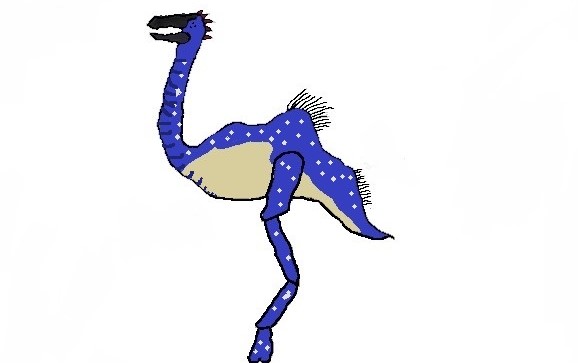Nomad
This creature is a large herbivore, at fourteen feet tall. Although they resemble birds, they are actually the largest member of the Avanacrur, a genus of herbivores and omnivores resembling birds, or insects.
Basic Information
Anatomy
Long, insect-like legs allow them to run quite fast, up to 30 mph if needed. They have a skeleton like that of a mouse or shark, one of cartilage.
Biological Traits
These large animals are similar to giraffes in role, reaching the higher branches and accessing the out of reach plants that smaller animals can't reach.
Genetics and Reproduction
They males are brighter than the females, who watch the nest after mating. After the eggs are laid, the male collects food and brings it to the female and babies once they hatch.
Growth Rate & Stages
Once the eggs hatch, they young are clumsy and unbalanced. After a few hours, they gain more mobility and start wandering around near the nest, under close supervision of the mother. After about a year, the remaining young leave and start on their own.
Ecology and Habitats
Largely herbivorous, they mainly eat leaves and berries, only eating grasses if needed. When it comes to meat, they usually go for small or young animals to swallow whole, as they don't have teeth. The meat is usually just for more protein, just as deer have been seen eating baby birds.
Dietary Needs and Habits
They usually go for more of the older or dead leaves, as they contain chemicals and acids in their gut that digests these near vitamin-less materials into actual food. They also swallow stones to help with digestion, like sauropod dinosaurs. They usually feed communally with other animals.
Biological Cycle
They are a vital seed spreader for many species of berries, as their feces contain seeds, which then sprout and start the process over again.
Additional Information
Social Structure
Often traveling in small herds, they are accepting of larger groups.
Domestication
The Barbro have come the closest to true domestication.
Uses, Products & Exploitation
Used as meat producers, also used as mounts, and for skins, as their hide, while not thick, is very tough.
Geographic Origin and Distribution
Along the Northern forests of the Eastern continent.
Average Intelligence
That of about a horse.
Perception and Sensory Capabilities
As a prey animal, they have good hearing and sight, although they don't seem to smell very good.
Symbiotic and Parasitic organisms
They are often raised by Barbro for meat or as mounts.
Scientific Name
Currere Stabit
Origin/Ancestry
Not sure.
Lifespan
Around thirty years.
Conservation Status
In the wild, they are very prevalent in the plains and sparse forests of the Eastern continent's North. In captivity, they are bred and kept by Barbro.
Average Height
At least 14 feet tall, males are a bit larger than females.
Average Weight
Around 4-5 tons
Average Length
8 feet long, not including the tail.
Average Physique
Average frames, but there is some variation.
Body Tint, Colouring and Marking
Largely a dark blue color with white spots sprinkled throughout. On some individuals there are black stripes going down the back.
Remove these ads. Join the Worldbuilders Guild









Comments